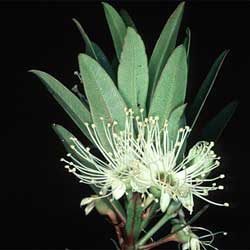Xanthostemon verticillatus
 Xanthostemon verticillatus Photo: Iain Dawson © ANBG |
 Xanthostemon verticillatus Photo: Iain Dawson © ANBG |
Xanthostemon verticillatus (C.T.White & W.D.Francis) L.S.Sm.
It is surprising that the stunning Xanthostemon verticillatus is not already a popular species in Australian horticulture. Apart from its horticultural potential aficionados will also appreciate its rarity and botanical interest.
 The botanical interest comes partly from its habitat, which is along the bouldery
river beds of the Daintree and Bloomfield area in north east Queensland where
it is subject to periodic inundation. Apparently it grows in the river bed,
not along the banks, so for several months of the year its roots will be very
wet. The technical term for plants preferring this type of habitat is rheophyte (= flowing-water plant), although this one may only qualify for the title for
part of the year. Fortunately it will also grow quite well in other environments.
The botanical interest comes partly from its habitat, which is along the bouldery
river beds of the Daintree and Bloomfield area in north east Queensland where
it is subject to periodic inundation. Apparently it grows in the river bed,
not along the banks, so for several months of the year its roots will be very
wet. The technical term for plants preferring this type of habitat is rheophyte (= flowing-water plant), although this one may only qualify for the title for
part of the year. Fortunately it will also grow quite well in other environments.
It is also unusual as it is the only plant in its genus that has its leaves arranged in whorls. In all the other 44 species they are either opposite or alternate. As this species is rare and has a very limited distribution there is obvious value in popularising it in horticulture as a strategy to help protect it.
Xanthostemon (pronounced zanthos-temon) is in the same family, Myrtaceae, as the familiar Eucalyptus, Verticordia (feather flowers), Melaleuca, Callistemon (bottle brushes) and Chamelaucium (waxflowers), but apart from similarities in their flower structure and the presence of oil glands on the leaves many people would not readily recognise the relationship. They are nearly all restricted to the wet tropics and some have the typical leafy look of rainforest trees.
Because of their habitat the rainforest species don't need leaves that are adapted to drought, unlike most of the better known species in the family. Only one Xanthostemon species appears to be reasonably common in the nursery trade, X. chrysanthus, which has bright yellow flowers. Several others have potential and interested readers should refer to Peter Wilson and Garry Sankowski's articles in 'Australian Plants' Vol. 16 (1992)*.
Xanthostemon verticillatus is very slow growing in south eastern Australia and will take many years to reach its potential maximum height of about 5 metres. It is therefore suitable as a container plant for patios and courtyards. It has very showy, cream flowers and beautiful dark green foliage. The flowers also have an attractive fragrance.
Its natural flowering time is spring, but in the glasshouses at the Australian National Botanic Gardens it flowers all year round with masses of flowers all summer. Flowering is enhanced with warmth and high light intensity (or elevated carbon dioxide in commercial greenhouse culture).
The individual flowers only last a few days but they are quickly replaced and the old flowers are easily removed. It grows well in a light potting mix with slow release fertiliser, full light and frequent watering but it must be kept warm. Being a tropical lowland species it will not tolerate frost or chilling and the night temperature should be kept above 12°C if possible. Propagation by cutting is moderately easy with IBA in talc (30-40% success is easily achieved and could probably be improved upon).
The only pest problems so far have been scale insects, whitefly and thrips but all have been easily controlled. I originally obtained this species to test it for suitability for indoor pot use. Unfortunately it is not tolerant of indoor light levels. However it thrives as a patio container plant or conservatory specimen and deserves to be popularised for those purposes.
* 'Australian Plants' is the journal of The Australian Plants Society
Name meaning: Xanthostemon verticillatus Xanthostemon - from Greek xanthos, yellow and stemon, stamens, verticillatus - a compound from Latin meaning 'having leaves arranged around the stem in a ring'. |
Text by Iain Dawson, ANBG (1996)
(Iain Dawson was in charge of horticultural
research at the Australian National Botanic Gardens in Canberra.
Some of the
information reported was obtained in collaboration with Dr Rod King when the
author worked for CSIRO Division of Plant Industry).
![An Australian Government Initiative [logo]](/images/austgovt_brown_90px.gif)

